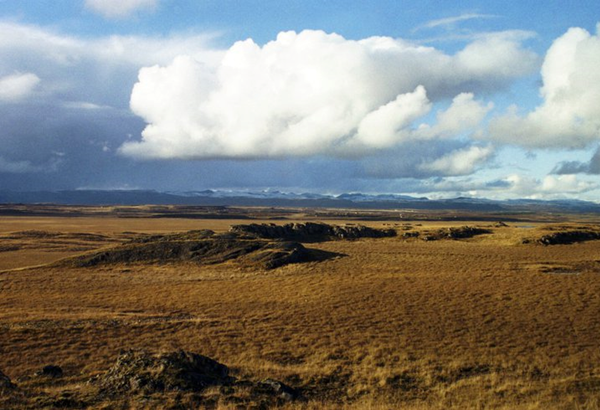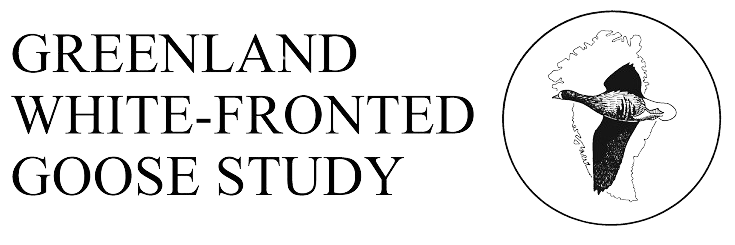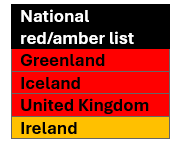
Keeping track of a vulnerable sub-species
What is this goose?
The Greater White-fronted Goose Anser albifrons breeds more or less continuously around the Arctic from Alaska through mid-continent Canada, in West Greenland and from European Russia to Far East Asia. The discrete population of the species that summers in west Greenland and winters in Britain and Ireland is the subspecies Anser albifrons flavirostris, which is the most morphologically distinct (being larger and most dark coloured) and most genetically distinct from all the other forms found elsewhere in the world. This is what the fuss is all about!
Why is this goose important?
Individuals from this population are amongst the largest and genetically distinct of any Greater White-fronted Geese anywhere in the world. This makes us think they have been relatively isolated from other forms for very many generations. At the moment, their numbers globally are small, currently numbering just over 18,000 individuals in 2023, having declined rapidly from some 35,600 at peak in 1999.
Where does this goose breed, stage and winter?
The Greenland White-fronted Goose summers and nests in west Greenland between Nuuk (64 degrees N) and Upernavik (72 degrees N). In autumn, it migrates to Iceland, where it stops off in the western and southern lowlands from mid-September to mid-November, before wintering in northern and western Scotland, Anglesey and mid-Wales, as well as in western, midland and northern Ireland. The greatest concentrations occur in winter at Wexford Slobs in SE Ireland and on Islay in the Inner Hebrides. The geese again stage during April in southern and western Iceland on migration back to their summering areas in spring.
How do we try to conserve the goose?
Research and volunteer actions are both key to the conservation of this goose….
What fieldwork and expeditions contribute to our knowledge of the goose?
Fieldwork across the full range of the GWGS habitat from Greenland to Britain and Ireland contribute greatly to our knowledge…
How can I help?
We rely on anrmy of volunteers to help us report back on breeding success and numbers, especially in the wintering grounds….
What has been written about the Greenland White-fronted Goose?
A great deal; from magazine articles to scientific journal articles. Find out more using this page as your starting point.
What is the Greenland White-fronted Goose Study?
Back in 1977 a group of students at Aberystwyth University started planning an expedition to Greenland to find out more about the local flock of Greenland White-fronted Geese. Find out more.
What’s a fun fact about Greenland White-fronted Goose?
Goose ecologists spend a lot of time gazing at goose bottoms, but there is a good scientific reason for doing so! Geese store the fat in their bodies that they later need to fuel long migration flights and to invest in laying a clutch of eggs and incubating them on the breeding grounds. Much of this fat is laid down under the skin and around body organs, but many wild goose species accumulate a thick block of fat in their abdomen, just under the tail. In the spring prelude to migration, this accumulation of fat becomes very conspicuous as the abdomen become distended. So much so that you can fairly accurately judge the fat content of a goose’s body from the shape of it’s rear end!
Where do the geese winter in Great Britain?
Zoom in and out below (cookies must be accepted to view). Click on a pin to find out more or use the menu above or the inventory page.
News updates
-

An Icelandic evening
—
in GeneralHigh on a lonely hill in the late afternoon and deep calls drift from a distant flight of swans as they flap their way slowly across the vastness that is the mire at Ferjubakki. Thin grasses bend in the chill breeze that blows from the far-off snowy mountains. There’s little sign of man’s presence here…
-

Background notes for press release
—
in General1. The Greenland White-fronted Goose Anser albifrons flavirostris is the most distinct sub-species of the circumpolar White fronted Goose Anser albifrons. It breeds in west Greenland and migrates through Iceland to winter exclusively in Britain and Ireland, where it remains one of the rarest of wintering goose populations. 2. The population declined from 17,500-23,000 in…

